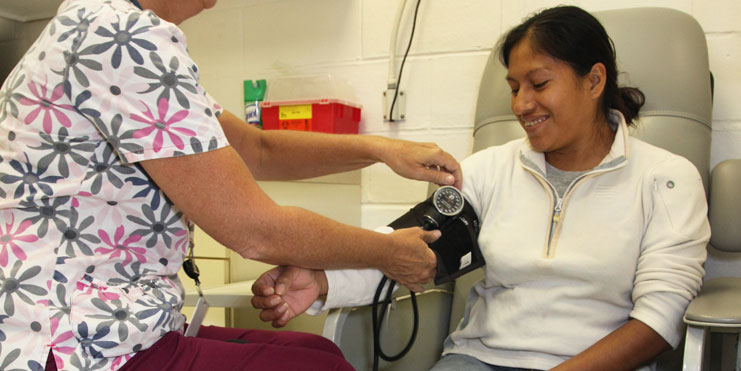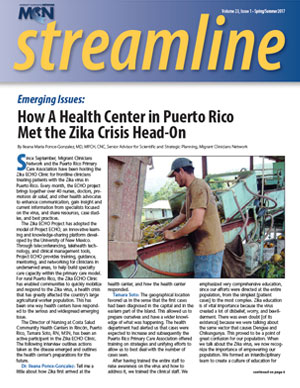PRAPARE: A New Protocol on Social Determinants of Health for Health Centers

Photograph by Earl Dotter
By Claire Hutkins Seda, Writer, Migrant Clinicians Network, Managing Editor, Streamline
Considering how health centers struggle to address all of an agricultural worker patient’s needs in the short window of time in the exam room, why would a health center ask a patient for more, seemingly non-health related information -- like if a patient currently has a job, is proficient in English, or has secure housing? Because socioeconomic situation has been shown to affect individual health, and any long-term strategy toward improving individual health must take into account underlying causes of illness. Health centers that collect relevant Social Determinant of Health (SDOH) data can document an individual’s risks and assets, give that person access to specific community resources, and use the data to shift its services to better address population trends, meeting health centers’ population health goals while reducing costs. Most importantly, a tool to collect that data can align with health center priorities and integrate into current electronic health record (EHR) systems to reduce startup time investment and assure a useful end product. That’s according to Andrew Hamilton, RN, BSN, MS, Alliance of Chicago’s Chief Informatics Officer and Deputy Director, and one of the many stakeholder developers of PRAPARE -- the Protocol to Respond to and Assess Patient Assets, Risks, and Experiences. The PRAPARE project coalition, spearheaded by the National Association of Community Health Centers (NACHC), the Association of Asian Pacific Community Health Organizations (AAPCHO), and the Oregon Primary Care Association (OPCA) and supported by the Institute for Alternative Futures along with the Kresge Foundation, Kaiser Permanente, and Blue Shield of California Foundation, has developed and piloted a national standardized protocol to help health centers understand and address its patients’ SDOH.
“As we move into a more managed medical world, we believe this is a critically important way of viewing our populations and understanding what the true health risks are. A relatively healthy person can have a high SDOH-related emergency room usage, for stress, anxiety, or depression,” Hamilton said by way of example. In addition to improving patient health, Hamilton emphasizes that addressing SDOHs can have a significant and positive effect on a health center’s bottom line. SDOH data analysis can lead a health center to develop non-clinical interventions, enabling services, or community linkages that can address the root causes of patients’ health concerns before expensive interventions, potentially reducing the total cost of care while improving patients’ long-term outcomes.
Development of the Protocol
About a year ago, stakeholders began convening weekly for two-hour meetings to drill down on how they were to develop the protocol. “We largely sourced from other survey instruments from each focal area. When we looked at questions around housing, we talked to representatives from the federal Department of Housing and Urban Development (HUD) program; when we were looking at questions around food and food security, we spoke with related entities,” he explained. While health centers already gather some of the information – like agricultural worker status – the protocol delves deeper, with questions on stress, education, material security, and much more, developing a broader and more detailed illustration of an agricultural worker’s daily life, helping to illustrate that not all agricultural workers need the same services. (See sidebar for a full list of PRAPARE core measures.)
Once the protocol was developed, the group began small focus groups, followed by a trial deployment with one provider’s patients at one health center. Hamilton explained that the team utilized the Institute for Healthcare Improvement’s Plan-Do-Study-Act (PDSA) cycle to test it out and tweak the protocol before larger-scale piloting, after which the group began to make the protocol compatible with the top four EHR systems most utilized by health centers across the country. After six months of planning, the group was ready to pilot the protocol.
Many of PRAPARE’s Core Measures overlap with Uniform Data System reporting requirements, so the system can be implemented to auto-populate the data a health center already has.
The PRAPARE Core Measures are:
- Race
- Education
- Ethnicity
- Employment
- Agricultural Work
- Insurance
- Veteran Status
- Income
- Language
- Material Security
- Housing Status
- Transportation
- Housing Stability
- Social Integration and Support
- Address/Neighborhood
- Stress
The Optional Measures are:
- Incarceration History
- Refugee Status
- Country of Origin
- Safety
- Domestic Violence
The material presented in this portion of Streamline is supported by the Health Resources and Services Administration (HRSA) of the U.S. Department of Health and Human Services (HHS) under cooperative agreement number U30CS09742, Technical Assistance to Community and Migrant Health Centers and Homeless for $1,094,709.00 with 0% of the total NCA project financed with non-federal sources. This information or content and conclusions are those of the author and should not be construed as the official position or policy of, nor should any endorsements be inferred by HRSA, HHS or the U.S. Government.
Piloting Across the US
Two clinics within Hamilton’s home health center, Alliance of Chicago, were part of several health centers that piloted PRAPARE last year. Clinics were chosen for diversity, with different patient demographics, geographic settings, and EHR programs. For Alliance of Chicago, the first step was plotting out how to integrate PRAPARE into its everyday processes.
“Early on, we had to determine, what would be the workflow? Will it be at the health center, or prior to the office visit?” Hamilton questioned. “There are lots of different ways that you could potentially collect these data,” and each method potentially had its own set of repercussions on staff time use and patient satisfaction. Once its workflow was set into place, the data began to flow in.
Preliminary data from four of the piloted clinics, representing almost 3,000 patients, showed diverse patient populations and an equally diverse list of SDOH risks and assets. One particular risk, though, popped up across the board: stress. “One of the things that is really clear is that stress is a huge concern,” Hamilton said. “How health center staff appreciate and understand the level of stress that their consumers are reporting, that might change the way we bring patients in from the waiting room, for example. It’s just about making people more aware.” Hamilton also pointed out that the data demonstrated trends among the assets identified in each community. Hamilton pointed out a low occurrence of domestic violence in one neighborhood as an example. “What does that mean for the community?” he questioned. A good reading of assets provides alternative profiles of the community and can once again help health centers tailor programs and services that are the most useful for the community and evaluate the efficacy of programs already in place.
The pilot showed that questions were well designed-- none of the questions were regularly skipped, which would indicate confusion or a lack of engagement on the part of the patient -- and the stakeholder group went back to work to develop a set of implementation tools, based on the experiences of the clinical pilots.

Photograph by Earl Dotter
Multi-step Implementation
To implement PRAPARE, health centers must first address both in-house workflow readiness and EHR virtual readiness. Staff must be educated on the protocol, senior staff must be engaged and on board, and project champions must be identified and readied. Critically, the workflow in the clinic must be diagramed and assessed to assure the protocol is adapted seamlessly and efficiently. The implementation plan provides plenty of guidance on staff engagement and workflow, including a readiness assessment, PDSA materials, a suggested timeline, sample progress reports, and more, all adopted based on the experiences of the piloting clinics.
Finally, the technology needs to be readied. The PRAPARE Implementation Plan has detailed EHR templates, sample data dictionaries, data specifications, and guidelines for design for each of the four most common EHR systems. But their Implementation Plan doesn’t stop there. It’s not all about how to get the information, Hamilton stressed -- the Implementation Plan also includes a critical “action toolkit.”
From Implementation to Action: How to Act on the Data
“The other thing in terms of readiness was the need to think about when you identify the issue, what was going to be your response,” Hamilton noted. Many clinicians, he said, might be uncomfortable asking untraditional questions about violence or having enough food to eat: “Patients might think, ‘I have a sore throat. Why are you asking me about food?’ Additionally, staff may be concerned to ask about issues like transportation when in fact the clinic doesn’t have a transportation resource to offer or even a community resource to recommend,” he admitted. The PRAPARE team built up additional FAQs, sample workflows, and other tools to “make sure you’re asking the right questions at the right time,” he said. He hopes the plan will equip trained clinicians to be comfortable and prepared to react: “You told me today that you have a problem paying for rent. We unfortunately don’t have a service to assist you in that issue right now, but we are collecting these data to better understand your needs and the community’s needs to better address these issues going forward,” Hamilton offered. Equally as critical, health centers are instructed to catalog both clinic-sponsored and community-wide resources that are available for each identified SDOH, so when a patient expresses a need, the EHR is set up to immediately recommend a set of action steps the clinician and/or the patient can take. “It’s not just about the questions, it’s about how you inventory the resources relevant to the issues that you are identifying,” Hamilton emphasized.
Now, the full suite of resources developed by the PRAPARE stakeholder group is available on NACHC’s website. The group has recently secured an additional round of funding to further examine how to link the protocol up with risk stratification, the next step in the development and utilization of this unique protocol.
Resources:
Visit NACHC’s website to read FAQs, access the Implementation and Action Toolkit, or view a recent webinar on the pilot program at http://www.nachc.org/research-and-data/prapare.
Read this article in the Spring/Summer 2017 issue of Streamline here!
Sign up for our eNewsletter to receive bimonthly news from MCN, including announcements of the next Streamline.
Return to the Streamline Spring/Summer 2017 Table of Contents.
